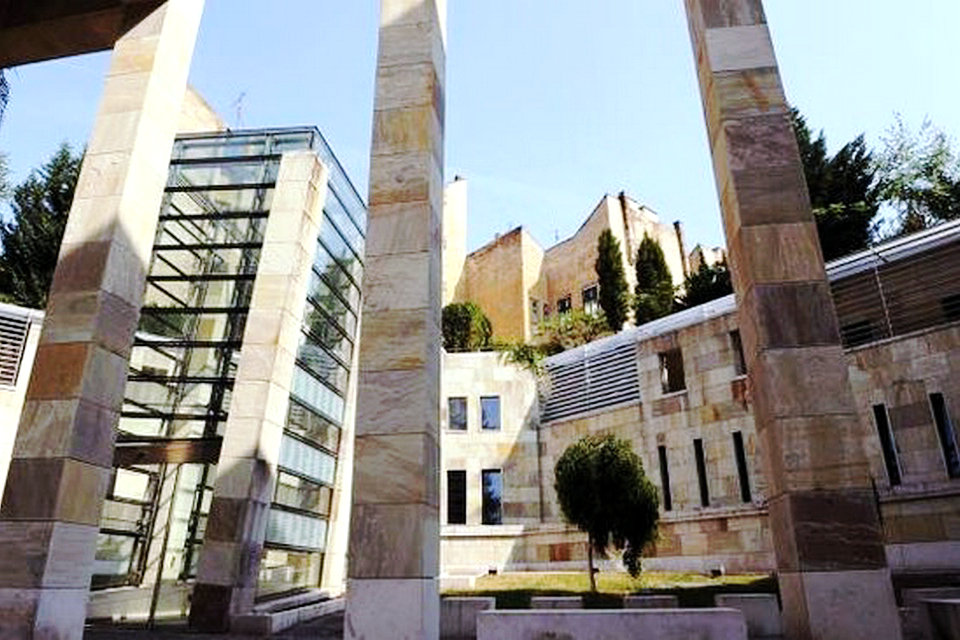The Holocaust Memorial Center (Holokauszt Emlékközpont) is a renovated synagogue that dates back to the 1920s and serves as a memorial and museum for and about Hungarian Jews that were killed in The Holocaust. While largely focused on Jews, the museum also mentions the discrimination and killings of Gypsies, Homosexuals, and the disabled. It is located in Budapest, Hungary.
The Holocaust Memorial Center in Budapest is a national institution established by the Government in 1999. It’s activities are focused on research and education of the Holocaust. The institution welcomes visitors with interactive permanent and special periodic exhibitions, experience-based museum pedagogical programs and cultural performances.
The Holocaust Memorial Center is a former synagogue, the Pava Synagogue. It was renovated and opened as the memorial and museum in 2004. The museum was designed by architect István Mányi. Architecturally, the building is asymmetrical. A set of stairs lead visitors to the exhibitions, meant to “symbolize the distorted and twisted time of The Holocaust.” There are permanent and temporary exhibits, and a research center.
The Holocaust Memorial Center is a national institution established by the Government in 1999. In 2002, it decided to construct the building of the Center in Páva Street, outside of the traditional Jewish quarter, further emphasizing its national character.
The Holocaust Memorial Center is one of the few institutions in the world, established by the state that focuses entirely on Holocaust research and education.
The visitors are welcomed into a unique space that was named as the most impressive in Budapest, beside the city’s panorama itself by Frank Owen Gehry, one of the leading architects in our time. The modern building is organically linked to the Páva Street Synagogue, an authentic venue that once used to be the second largest site for Jewish worship in Budapest.
The Institution is a center for scientific research education and culture. It welcomes visitors with interactive permanent and special periodic exhibitions, experience-based museum pedagogical programs and cultural performances. Guided tours are available in five languages and special, thematically focused tours are offered regularly. A bookshop and a cozy coffee shop contribute to a memorable visit.
The Holocaust is anguish of the whole Hungarian nation, causing immeasurable loses in human lives and spiritual values. The Memorial Center researches and processes the history of persecution of the Hungarian Jewry and citizens declared to be Jewish based on contemporary racial acts, its triggering factors, the impact of the catastrophe and the consequences of the losses, as well as the reasons of breaking with the Hungarian historical traditions of coexistence.
The Institution considers that preserving the memories of the tragedy, as well as reconciliation are a national issue. The existence of the Center by itself is a token of piety by the Government, the Hungarian nation and society toward all the victims of the Shoah, our persecuted and slaughtered innocent compatriots, respect toward the Righteous Among the Nations and every unselfish rescuer.
The Memorial Center is a site for collective morning and compassion with the victims and, at the same time, a venue for its enduring and adequate display. It is an important workshop of the national remembrance, its methodological focal point and catalyst. It demonstrates the importance of respecting human rights and the responsibility of protecting human lives; it radiates responsibility for the future by scientific research and realistic presentation of the past.
It has to amend a major historical omission by overcoming the ignorance of the topic caused by decades of sinful silence. For is social acceptance, high morality, devotion and credibility, respect for religious values and piety, as well as an air of openness are indispensible.
Toward the street an archway, separated by a stone wall, has been erected, communicating outward protection, and inward underlining the eternity of the Memorial Wall. The emphasis is on evoking the silence.
In the mental power field that has shaped the building we examined analogies from the nature. In the power-struggle of tensioning blocks, the horizontal is not horizontal, neither the vertical, and perhaps even the gravity is suspended. The symbols of architecture suggest that everything here is beyond the normality, as the Holocaust itself is unexplainable within human history. The glass hall of the entrance leading to the permanent exhibition is also supported by tilted pillars. The inspiration from the nature came from Tuscany, where a line of pine trees took the same tilted form under the pressure of the permanent sea storms. the murdered as a symbol of thousands of years of constant struggle for survival, endurance, and wished to generate the same image to the visitors.
